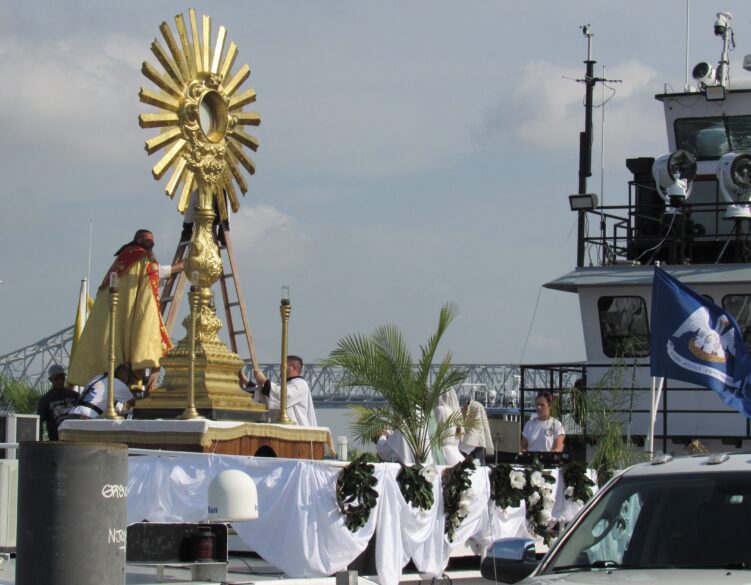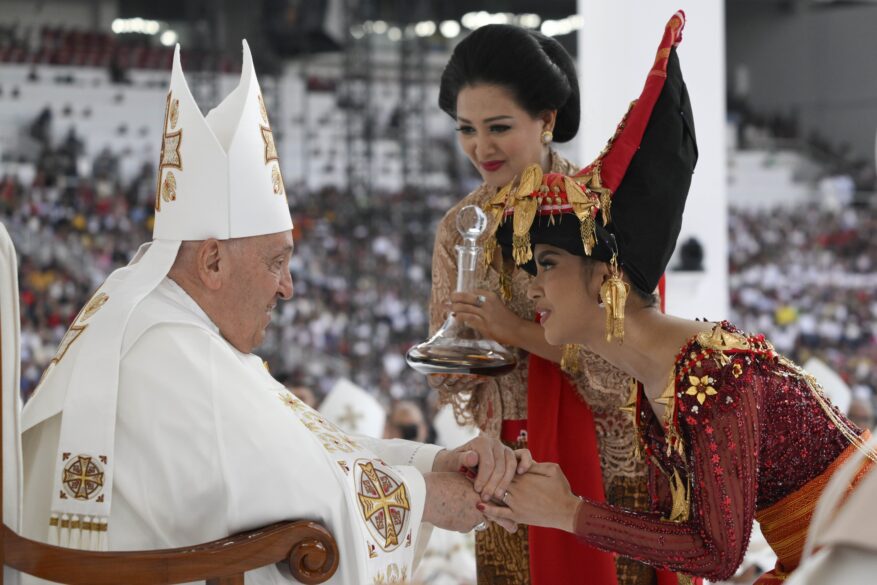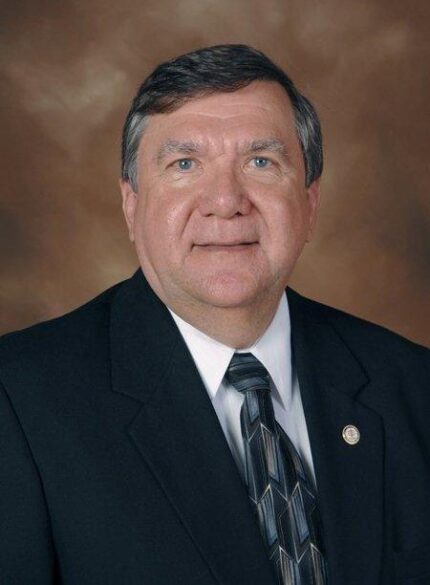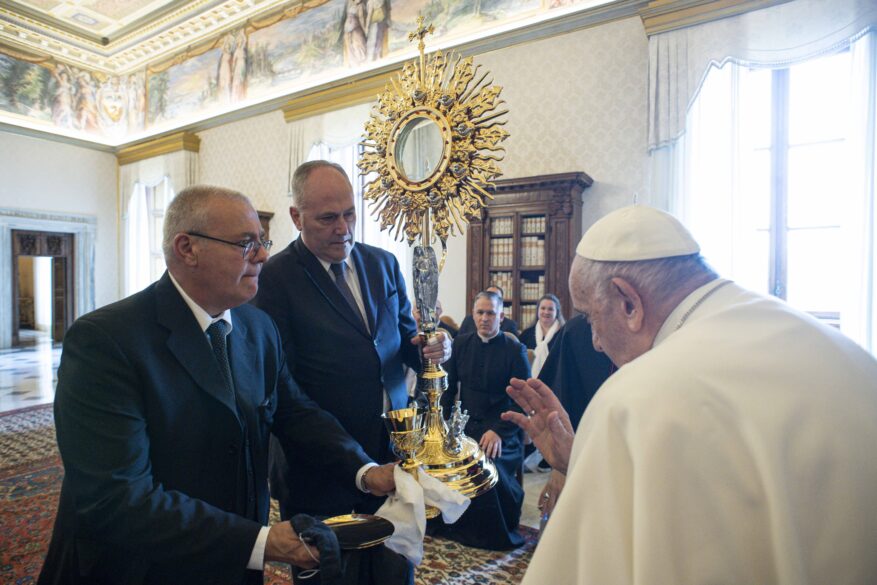By Gina Christian
(OSV News) – An annual Eucharistic procession on a Louisiana bayou moved to the mighty Mississippi River this year as part of the National Eucharistic Revival – and graces are set to overflow, the lead organizer told OSV News.
Some 15 boats accompanied the Blessed Sacrament an estimated 130 miles along the Mississippi River Aug. 14-15 for the Fête-Dieu du Mississippi.
The procession launched in Baton Rouge, Louisiana, following a morning Mass celebrated by that diocese’s Bishop Michael G. Duca at St. Joseph Cathedral.
Archbishop Gregory M. Aymond of New Orleans concluded the event Aug. 15 at that city’s Cathedral Basilica of St. Louis with Benediction and a Mass marking the feast of the Assumption of the Blessed Virgin Mary.
Rallies, spiritual talks, adoration, confession and recitations of the rosary took place at various ports of call along the route, with speakers and prayer presiders including author Father Josh Johnson of the Diocese of Baton Rouge, Dominican Father Aquinas Guilbeau of The Catholic University of America and Father Dustin Dought, executive director of the U.S. Conference of Catholic Bishops’ Secretariat of Divine Worship.

Father Michael Champagne of the Community of Jesus Crucified founded the procession a decade ago as the Fête-Dieu du Teche, the bayou where he’d grown up.
The Bayou Teche, an ancient channel of the Mississippi where French Catholics known as Acadians settled in the 18th century, was a natural inspiration for the procession, Father Champagne told OSV News.
And fittingly, the first discussions about the Fête-Dieu took place on the banks of the bayou, said the priest, whose religious community of men and women serve as “missionary contemplatives,” blending monastic prayer and active evangelization.
“I had the nuns with me in the truck, and we were driving on the Bayou Teche and saying, ‘We’ve got this anniversary coming up for the 250th anniversary of the arrival of the Acadians … and we need a Eucharistic procession on the bayou,’” said Father Champagne. “When the Acadians came, they came with their priest, they came with their flag of the Blessed Mother and they brought their faith. So I said, ‘Why don’t we reenact their arrival, and instead of doing that in boats dressed up like Acadians, let’s do a Eucharistic procession, and just move it onto the water?’”
Soon the 40-mile procession swelled to include “as many as 80 or 90 boats on the bayou,” he said.
But this year, the Fête-Dieu was put out into the deep – literally, said Father Champagne.
While the 125-mile Bayou Teche has an average depth of 5 feet, the 2,350-mile Mississippi River – despite reaching some critically low water levels in recent years – plunges to 200 feet at Algiers Point near New Orleans.
The shift in location has made for “a complicated endeavor,” admitted Father Champagne, noting that planning for this year’s procession, which required detailed logistics and permission from multiple officials, began over two years ago.
“We’re involved with the pilots’ association, the port authorities, nine sheriffs’ departments and the Coast Guard, which is supervising the procession,” he said.
Only commercial vessels operated by licensed river pilots, carrying “a handful of civilians” including the priests safeguarding the Blessed Sacrament, will be out on the water, with the average speed of the craft about 10 knots (approximately 11.5 miles) per hour, said Father Champagne.
But those on the banks were nonetheless able to participate in a rich “spiritual tailgating” experience as they witnessed the historic procession and honored the Blessed Sacrament in the port of call gatherings, he said.
Even the most casual observer had no trouble seeing the host, which was displayed in a 14-foot-tall monstrance crafted by Father Champagne’s cousin by marriage, Lyndon Stromberg of the Texas-based Stromberg Architectural.
Stromberg told OSV News that Father Champagne had provided him with a “an old antique monstrance … and said, ‘Can you make me something like this?’”
The “genius entrepreneur,” as Father Champagne described him, set to work modeling and refining a design, creating a mold for casting the monstrance in fiberglass over a metal frame, and finishing the surface in gold leaf.
A team of “about a dozen” staff worked on the project for a year, said Stromberg, noting that he and his team donated time and material for the 220-pound monstrance.
“A lot of them are Catholic, so we had people bringing their spouses and kids to show what mom and dad were working on,” Stromberg said.
The procession has also become an ecumenical encounter, said Father Champagne.
“I’ve been meeting with tugboat companies and pilots and industry guys that worked on the river their whole life,” he said. “One guy told me, ‘Look I’m Baptist, I’m not Catholic. I’ve been on the river 50 years, and it’s never been blessed. We got to bless the river, man. I’m all in.’ And another guy who’s not Catholic completely renovated one of his boats, with lots of money invested, just because he’s going to carry a statue and bells.”
As the procession looked to “bless the state of Louisiana and the Mississippi River … by bringing Jesus down a good swath of it,” Father Champagne hopes that participants were swept from the shallows of faith into a current of desire for Christ.
“I couldn’t imagine life without being in the presence of the Lord,” he said. “And I’ve got to go deeper, I’ve got to be more and more preoccupied with the Lord, and bring people to the Eucharist.”
(Gina Christian is a multimedia reporter for OSV News. Follow her on X (formerly Twitter) at @GinaJesseReina.)







